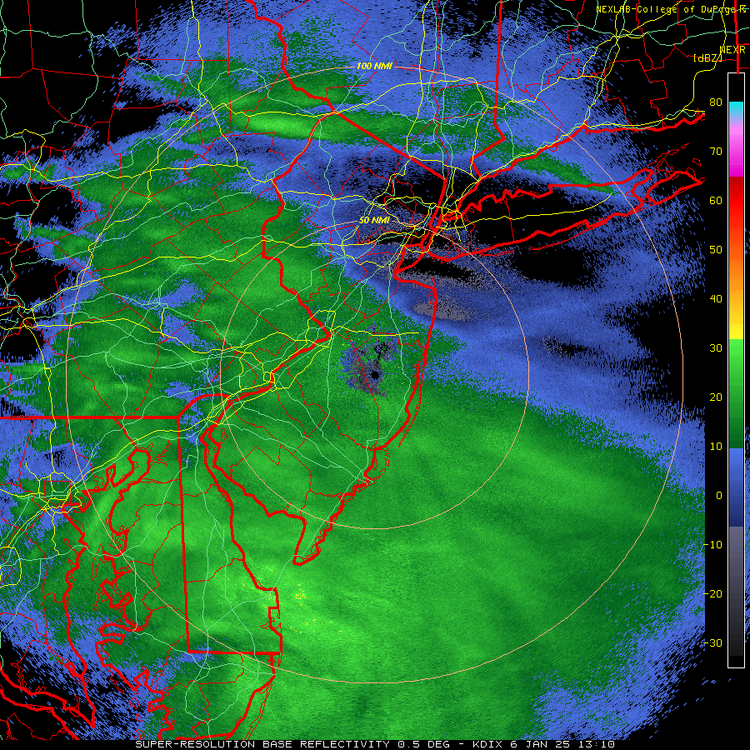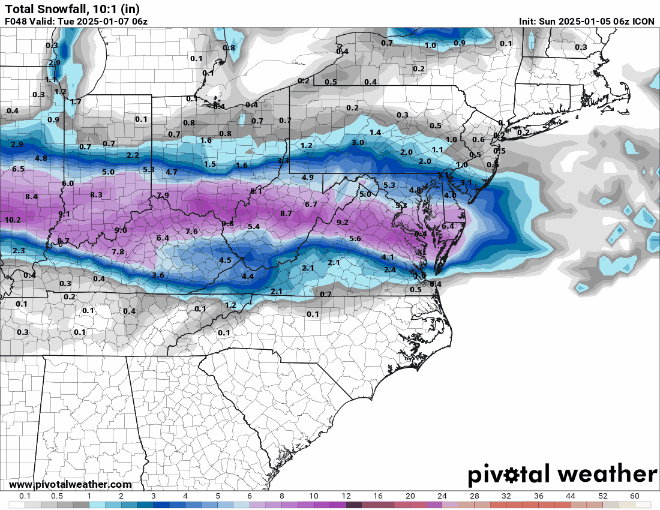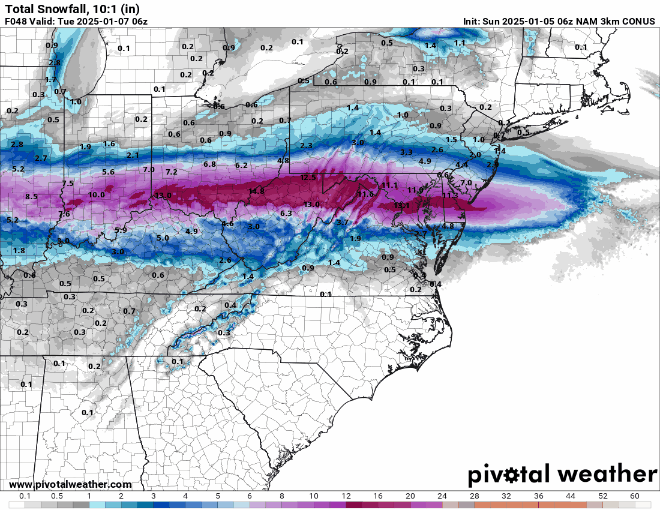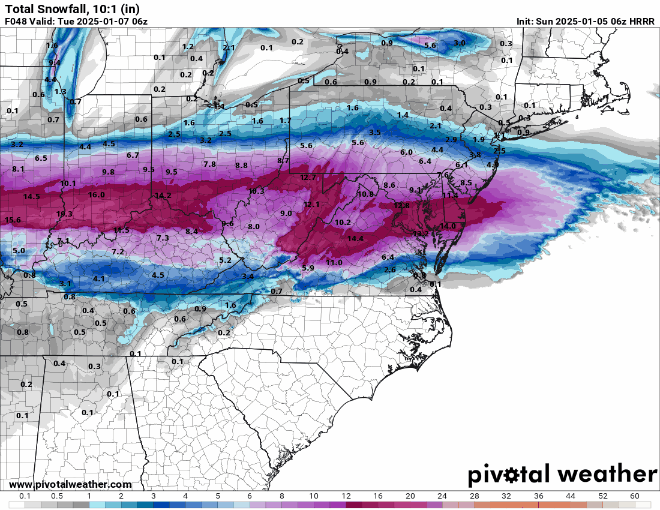
RU848789
Members-
Posts
3,656 -
Joined
-
Last visited
Content Type
Profiles
Blogs
Forums
American Weather
Media Demo
Store
Gallery
Everything posted by RU848789
-
Snowfall NYC subforum Jan 6 and OBS if needed
RU848789 replied to wdrag's topic in New York City Metro
In a bit of a lull now with very light, fine, pixie dust flakes falling, but radar looks nice approaching us from the SW, so should pick up soon. We're up to 0.4" as of 10:50 am (2 hrs) and it's still 26F. And brining works by the way for light snows like this: the street we live on, which was brined, is just wet, but the street that feeds into it is 100% snow covered. -
1/6 snowstorm - nuisance event or something bigger?
RU848789 replied to LVblizzard's topic in Philadelphia Region
Grew up in Whitman Square - WTHS Class of 80. Hope you get to at least 3" down there. When I was a kid it always seemed like south and east of Philly - us - did much worse than north and west of Philly (usually due to mixing/changeover), but this could be your chance, lol. -
Snowfall NYC subforum Jan 6 and OBS if needed
RU848789 replied to wdrag's topic in New York City Metro
Yeah, I have friends in Mays Landing and Northfield who are getting heavy snow with a few inches OTG already. -
Snowfall NYC subforum Jan 6 and OBS if needed
RU848789 replied to wdrag's topic in New York City Metro
Yes, I edited my post, as I hadn't seen the 12Z NAM/RGEM/ICON all upping totals to 1-1.5" (and 2" in spots) for areas N of 276/195 up to 78, i.e., CNJ, so maybe I spoke too soon. -
Snowfall NYC subforum Jan 6 and OBS if needed
RU848789 replied to wdrag's topic in New York City Metro
13Z and 14Z HRRR, still have 1"+ for CNJ from 9 am through 2 pm. Not buying it. My guess is the Euro is going to end up being the model winner for the overall storm in the NE US at least, looking at its consistency for days showing a lighter event than other models and less than most forecasts, including the NWS. Edit - hadn't seen the 12Z NAM/RGEM/ICON all upping totals to 1-1.5" (and 2" in spots) for areas N of 276/195 up to 78, i.e., CNJ, so maybe I spoke too soon. -
1/6 snowstorm - nuisance event or something bigger?
RU848789 replied to LVblizzard's topic in Philadelphia Region
Been snowing lightly for about an hour and we have a whole 1/4" OTG as of 9:50 am, lol. NWS discussion said they're sticking with their forecast amounts, but I have my doubts for most of CNJ, especially the northern half towards 78, getting to 1" and for Philly getting to 3", looking at the radar, although it can always fill in more. It is covering all surfaces, which is no surprise at 26F, so paved surfaces are slick already. It is a very pretty snow - light and fluffy consisting of small dendrites. Edit: Well, all of a sudden, the 12Z NAM/RGEM/ICON came out, all upping totals to 1-1.5" (and 2" in spots) for areas N of 276/195 up to 78, i.e., CNJ, plus the 13Z and 14Z HRRR are showing 1"+ for CNJ from 9 am to 2 pm, so maybe I spoke too soon, especially as the radar in eastern PA from Philly to Allentown has blossomed and is heading our way - depends if it holds together or dries up/falls apart. -
Snowfall NYC subforum Jan 6 and OBS if needed
RU848789 replied to wdrag's topic in New York City Metro
Been snowing lightly for about an hour and we have a whole 1/4" OTG as of 9:50 am, lol. NWS discussion said they're sticking with their forecast amounts, but I have my doubts for most of CNJ, especially the northern half towards 78, getting to 1" and for Philly getting to 3", looking at the radar, although it can always fill in more. It is covering all surfaces, which is no surprise at 26F, so paved surfaces are slick already. It is a very pretty snow - light and fluffy consisting of small dendrites. -
Snowfall NYC subforum Jan 6 and OBS if needed
RU848789 replied to wdrag's topic in New York City Metro
Snow started here around 8:45 am and it's been light to almost moderate now with a nice coating on the ground. Very pretty and nice to not have to worry about melting. -
Snowfall NYC subforum Jan 6 and OBS if needed
RU848789 replied to wdrag's topic in New York City Metro
Looks like light to maybe moderate accumulating snow in green, which is advancing towards NENJ, so hopefully we can get a bit of snow this morning here. -
It's amped, all right, across the deep south, until it fizzles, just nowhere near us...
- 993 replies
-
- metsfan vs snowman
- bomb
-
(and 2 more)
Tagged with:
-
But if the GFS verified, could you imagine the wailing and gnashing of teeth from NYC to Boston if coastal DE gets 3 feet in one week and NYC to Boston get an inch or two?
- 993 replies
-
- 1
-

-
- metsfan vs snowman
- bomb
-
(and 2 more)
Tagged with:
-
Rain is never off the table 6 days out for us.
- 993 replies
-
- 1
-

-
- metsfan vs snowman
- bomb
-
(and 2 more)
Tagged with:
-
6" along 95 and a lot more towards the Jersey Shore at Day 6? Where do I sign?
- 993 replies
-
- metsfan vs snowman
- bomb
-
(and 2 more)
Tagged with:
-
Snowfall NYC subforum Jan 6 and OBS if needed
RU848789 replied to wdrag's topic in New York City Metro
You are mostly correct as my numbers were wrong. I actually had about 54" of snow in 2010-11, not 40" and I had 55" in 2009-2010, which is just barely more. I didn't start keeping a spreadsheet until about 10 years ago, so I was just looking at my weather email archives and missed a couple of decent storms in 10/11 and double counted one in 09/10. FYI, we had 23" for Boxing Day and 17.5" for 1/26, but also had 8" on 1/11, 3" on 1/20 and a couple of 1-2" events. I really need to go back and put these old winters in the spreadsheet, lol. Started doing the winter weather emails for every storm in 2000; was sporadic prior to that, usually just for the bigger ones. Below is the link to the NB snowfall history, which is always useful to check against for folks not far from there, like you and me, although note that their "total" column is the annual, not the winter total - nobody cares about the annual, lol, so one has to add up all the monthly rows to get the winter total. I just emailed them to see if they could address that. https://climate.rutgers.edu/stateclim_v1/monthlydata/index.php?stn=286055&elem=snow -
Snowfall NYC subforum Jan 6 and OBS if needed
RU848789 replied to wdrag's topic in New York City Metro
NWS updated 4 pm snowfall map is out and it cuts snowfall back just a bit vs. the 4 am package which did look a bit overdone, with the 1" line moving from about 80 to just N of 78 with only 1/2"-1" N of 78, including NENJ and NYC/LI. This also means CNJ is in the 1-2" range for the most part with the 2" line a little N of 276/195 and with the 3" line from just north of Philly to about Toms River, while the 4" line goes from just south of Philly to LBI. The forecast is for 4-6" south of there and then 6-8" south of a Wilmington to AC line. Looks like my 1.5" prediction for Metuchen is solid. No warning/advisory changes for counties along/S of 276/195. And bust potential has decreased, given the decrease in snowfall forecast by the NWS and increases in snowfall from the global models at 12Z and 18Z, so far, such that the globals are much closer to the still a bit snowier mesoscale/CAM models like the RAP/HRRR. However, <1" is still possible for CNJ, as is 2-4" if the storm under/overperforms and there are +/- 1-2" risks for SEPA/SNJ depending on how the storm performs. Almost radar time. -
Snowfall NYC subforum Jan 6 and OBS if needed
RU848789 replied to wdrag's topic in New York City Metro
2009-2010 was way better than 2010-2011 for me, with about 60" vs. about 40", respectively (similar in NB), whereas for CPK 2010-2011 had 61.9" vs. 51.4" for 2009-2010. For 2/25/10 we got about 19" here. -
Snowfall NYC subforum Jan 6 and OBS if needed
RU848789 replied to wdrag's topic in New York City Metro
Ok, every global has bumped up snowfall amounts at least a bit, so CNJ is not shut out on any of them, although we're only talking 1/2-1" for most with up to 1.5-2" as one nears 276/195 - and Philly gets at least 2" on all of them (except the UK which is still an outlier but not nearly as much as it was). Point is this appears to be some convergence with the mesos/CAMs which still mostly show more, especially the HRRR/RAP. At this point, it's time to make a guesstimate, so I'm going with 1.5" at my house in Metuchen, as I like the trend on the globals and think the mesos/CAMs might do better on this storm. Unfortunately <1" is still on the table, but so is 2-4", at my house and for most of CNJ, especially towards 276/195. -
Snowfall NYC subforum Jan 6 and OBS if needed
RU848789 replied to wdrag's topic in New York City Metro
Most of the globals have moved north with their precip shields at least a bit (especially the UK), so maybe we're seeing some convergence between the two camps finally. Let's see what the Euro says... -
Snowfall NYC subforum Jan 6 and OBS if needed
RU848789 replied to wdrag's topic in New York City Metro
6" in Metuchen on 2/6/10. Here's part of my recap from that one...(I post a lot more elsewhere, lol, but you kind of asked). Ok, here's the recap. Well, I obviously spoke too soon yesterday morning (may need to get myself a "Jump To Conclusions" welcome mat - name that movie), as the next 5-7 hours brought the heaviest snow of the storm to many places including finally punching through the dry/cold air in most of Central Jersey, so that I at least got 6" of snow in Metuchen and everywhere south of Central Jersey kept getting hammered, meeting and even exceeding the amazing accumulation forecasts. The only area that most of the pros "busted" was NE NJ, NYC (except SI) and LI and anywhere north of there. However, overall, the forecasts were pretty damn good for a perhaps the most complex snowstorm to hit this area in a long time. · NW NJ (Warren/Sussex/Morris), Bergen, Passaic, Essex and Hudson Counties, NYC, LI, CT and everywhere north of there essentially got shut out, except for an inch or two of snow in the southern parts of a few of those counties. There was nearly mass weenie suicide on the NYC metro thread on Eastern. · Central Jersey from about 78 down to a line from Trenton to Asbury Park generally got 6-12" of snow, except close to NYC, where most of Union County and most of Staten Island got 2-4" of snow; the larger amounts were to the south, of course. · Interestingly, areas in PA that are at the same latitude as most of Central Jersey (i.e., Bucks, Berks and northern Montgomery Counties), got much more snow (12-18"), as they were further away from the "confluence" of incoming dry/cold air that squashed accumulations in NYC. · Between the line from Trenton to Asbury Park and a line from Philly to Toms River, most locations got from 12" to 20" of snow and from Philly to Toms River and points southward, most locations got 20-30", which is an enormous amount of snow · The jackpot for snow accumulation was from about Philly (28") and adjacent South Jersey and the SW suburbs of Philly down through most of DE, the DC-Baltimore area, NE MD and northern VA (and even WV) where 24-36" accumulations were observed. · So how's this for a gradient? Simply moving down I-95, here's the progression of snowfall: 0.0" in Central Park, 1/2" in Newark, 1" in Elizabeth, 4" in Rahway, 6" in Metuchen, 8" in New Brunswick, 13" in Trenton, 19" in Mount Holly, 28" in Philly and 30" in Baltimore. Unprecedented, especially the 0-28" over the ~90 miles from NYC to Philly. -
Snowfall NYC subforum Jan 6 and OBS if needed
RU848789 replied to wdrag's topic in New York City Metro
GFS is as close at 12Z to 6Z as it could be, so no movement there...posting Kuchera map given Walt's comments on any banding likely having good ratios aloft (which probably is close to Kuchera's greater than 10:1 ratio based on max column temps). -
Snowfall NYC subforum Jan 6 and OBS if needed
RU848789 replied to wdrag's topic in New York City Metro
I post on the 33andrain Discord, but also find it harder to navigate/follow, plus it has a ton of useless banter mixed in, but it does have more meteorologists posting model play by play and other commentary, which I do like. And I also post a lot more on FB and a couple of other boards. And great points on the NWS - feel similarly, although I also dislike the harsh bashing they get when a forecast is wrong or even just a bit off, as many simply don't understand how complex the weather is and that it's still impossible to accurately predict precip/snowfall (especially in mixed precip events) several days in advance and even, sometimes 12 hours in advance, lol. It's not that they're bad scientists - this is just really hard stuff to get right. -
Snowfall NYC subforum Jan 6 and OBS if needed
RU848789 replied to wdrag's topic in New York City Metro
And, of course, the ICON jumps north, so maybe the two camps are going to just move towards each other. That would at least be better than a complete shutout for areas N of 276/195. -
Snowfall NYC subforum Jan 6 and OBS if needed
RU848789 replied to wdrag's topic in New York City Metro
The NAMs and HRRR moved significantly south at 12Z - see my post a few posts ago. Fat lady is warming up. -
Snowfall NYC subforum Jan 6 and OBS if needed
RU848789 replied to wdrag's topic in New York City Metro
12Z NAM and NAM3K and HRRR backed off a fair amount on snow, especially towards Philly, although they're still a lot snowier than most of the globals. Wonder if the mesos/CAMs are starting to cave to the globals today at 12Z. -
Snowfall NYC subforum Jan 6 and OBS if needed
RU848789 replied to wdrag's topic in New York City Metro
Very interesting that the NWS bumped snowfall back up for areas N of 276/195, including CNJ/NNJ/NEPA/NYC, with their 4 am forecast, as per the map below; it's fairly similar to the Channel 7 forecast. Their 1" line moved from just south of 78 to about 80, except for NENJ (Union/Essex/Hudson) and NYC/LI, where <1" is forecast, and their 2" line is now from about Frenchtown to Sea Bright and the 3" line is along 276/195 (was 10-15 miles south of there); south of that 3" line very little change. The NWS discussion doesn't have the usual "model discussion" section at 4 am. In contrast, TWC has the 1" line along 276/195 with <1" north of there and the 3" line from about Wilmington to AC, as do others, while News12NJ is between the two camps with their 1" line from about Frenchtown to Sea Bright and their 3" line from Philly to LBI with 3-6" south of there. Bust potential is pretty high, IMO, as the global models at 0Z last night and 6Z this morning continue to show much less snow than this across the board, as all of you know, with generally <1" N of 276/195 and even only an inch or two for the Phillly/SNJ area; they must be leaning more towards the meso/CAM models, like the NAM3K, HRRR, RAP, SRERs, etc., which show amounts similar to the NWS map (or even more). From a meteorological perspective, this is a fascinating conundrum to have these two camps so far apart, but from a "client" perspective it's very frustrating to have such low confidence in the NWS forecast.





